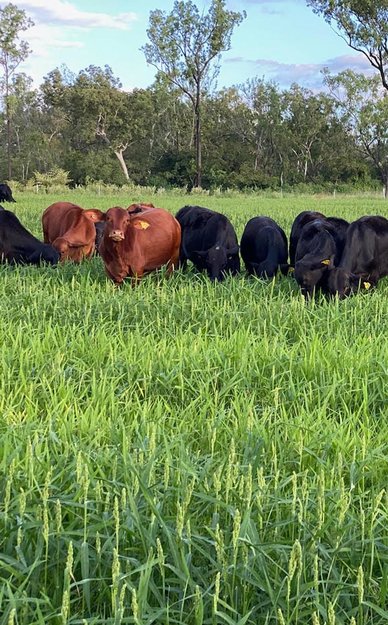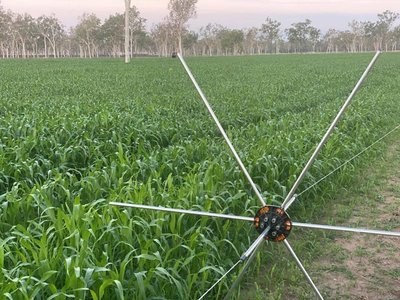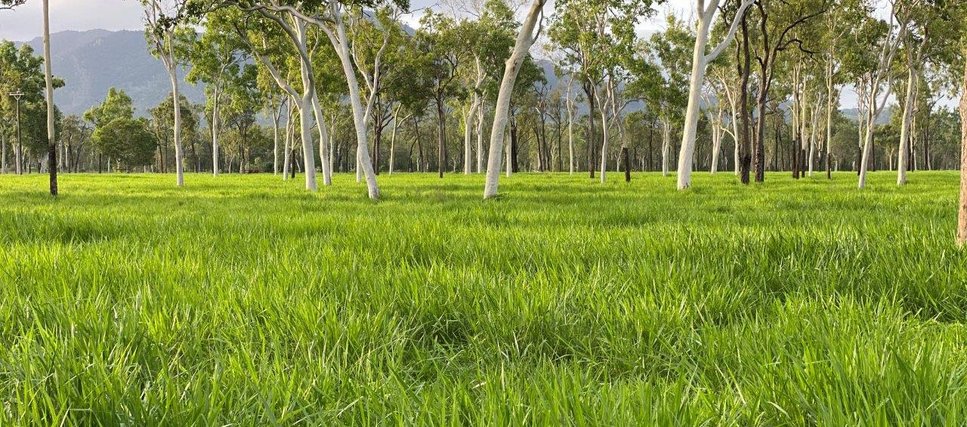Building a future beef enterprise

To build a future paddock to plate beef operation, takes hard work, dedication and the right pasture for the property. In a short period of time, Pure Produce Hervey Range Regenerative Farms is well on its way to creating that dream.
The aim for the property is to develop an on farm beef production system, including processing with improved beef genetics. The farm has found that Ultrablack bulls over Droughtmaster females has proven to be a great success. Located in the district of Hervey Range, west of Townsville, the soil is sandy loam, pH of around 6.5 and when Luke St. George bought the property in 2019, it was heavily infested with woody weeds and limited pasture grass was available.
Prior to the Hervey Range property, Luke owned and managed a mixed farming operation producing hay, silage and beef cattle. The farm was located on the banks of the Burdekin River and was highly productive in its early days. However, Luke became increasingly dismayed at the amount of nutrient loss and consequently, inputs needed each year for production under the standard industrialised farming model.
A new start, and a new way of thinking has seen the Hervey Range property transform in less than three years, using dryland pasture mixes suited to the property, and crops under irrigation.
The first actions were to clear the weeds, prepare the ground and plant a seed mix for dryland pasture that would compete with any weed regrowth and add nutrients to the soil. Simple chicken manure for fertiliser was used before broadcast sowing of the pasture seed.
“We have a strict slashing program while the grasses establish,” says Luke.
“We will keep topping the grass with the slashers, to knock the weeds out. As they get under control and the pasture starts to establish, then we introduce the cattle on a grazing program. We use the old rule of thumb of graze a third, trample a third, leave a third, and move the cattle out to the next paddock.”
Barenbrug FNQ Territory Manager, Greg Forsyth was approached initially for agronomy advice for centre pivot irrigation and dryland pasture. As a result, a number of pasture custom mix configurations have been trialled for the dryland paddocks and irrigation. The mixes for dryland pasture are based on Endura Rhodes grass and Signal grass, with Wynn Cassia naturalising as a ground cover legume.
For the irrigated parts of the property, blends of clovers, beans, peas and sorghums have been tested. To date Japanese millet and soy have been successful, but Luke says he learned pretty quickly that sorghums in the same mix were not a good idea as the plant’s height dominated the pasture such that shorter varieties struggled to establish.
While the aim is to establish a paddock to plate beef enterprise, without good soil and feed, the pasture cannot give liveweight gains and quality meat. Using the principles of regenerative farming means for Luke that improvements in soil health, plant nutrient density and minimal inputs will give the desired outcomes. Once established, it is anticipated that the dryland pasture and irrigated mixes will give a weight gain of around 0.9kg per day for a finished animal at around 480-500kg liveweight.

“For ten years as a hay and silage farmer we watched the soil degrade, with fertiliser added every year. At this property and with a change in management processes towards a regenerative farming model, we will probably still add fertiliser, but at a far less rate.
“Ultimately what we are trying to achieve is improved soil health, nutrients and organic matter for our paddock to plate enterprise in beef.
“We want the animals to be able to graze selectively what they need on any given day to give them the highest performance. It might be a legume today, or a brassica tomorrow. We figure they know best what their needs are, we just provide the salad bowl.”
Greg has helped Luke to appreciate that achieving a persistent and productive pasture is more than planting seed.
“Luke has been pretty quick to adapt to the needs of his farm to get quality pasture going for his beef production and the benefits that the right mix can bring for soil improvement and for his cattle,” says Greg.


